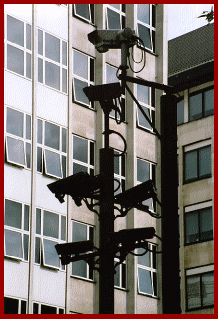| ||||||||||||||||||||||||||||||
Welcome to the | ||||||||||||||||||||||||||||||
 | ||||||||||||||||||||||||||||||
 | ||||||||||||||||||||||||||||||
So you want to know more about Digital, | ||||||||||||||||||||||||||||||
Now our second level of digital sophistication, takes us on to what is quite literally a CCTV computer, also widely known as a "DVR" or "Digital Video Recorder". This increasingly common piece of equipment is rapidly replacing the older technology analogue Time Lapse Video Recorders (VCR), as the key component in many smaller to medium size systems. Whilst the internal workings of the unit are essentially digital in nature, the signals coming in from the cameras, and going out to the monitor are generally analogue; so there is a degree of inefficiency in having to convert from analogue to digital to record, and then from digital back to analogue to replay pictures onto a standard CRT or LCD monitor. Some models conveniently bypass this latter stage by outputing in a format compatible with standard 'digital input' computer monitors. Digital Video Recorders are actually available in two main types, and whilst they both do pretty much the same thing, each has its pro's and con's. 'Standalone' DVR's are custom designed and built into a conventional desktop box, with controls often laid out in much the same way as an older Time Lapse Video machine. That said, they are available in a wide range of models and functions, with many combining the basic functioning of a video recorder, but also incorporating all the benefits of a built in multiplexer. Typically, models are available offering inputs from a single up to 32 channels of video .... or more! Apart from the conventional Standalone units, there are a number of manufacturers who cater specifically for those requiring 'PC' based recorders, whether ready built, or supplied as a series of self assembly printed circuit 'boards' that can be built into a highly specified DVR. In practice, this latter option is really only suitable for someone with a good working knowledge of Computer IT systems. Now it's probably not unfair to say that within the CCTV industry itself, there is a small degree of controversy over the merits of PC machines versus Standalones. In some countries, PC recorders offer a low cost highly sophisticated solution to security video recording. In others, Standalones will be the preferred option, being generally more 'contained' and easy to use, and to a lesser degree, more compliant in terms of evidential suitability. | ||||||||||||||||||||||||||||||
 | ||||||||||||||||||||||||||||||
IMPORTANT: No material may be reproduced, copied or redistributed from this site, © doktorjon.co.uk 2004 - 2008 Homepage...:...Gateway...:...Technical Gateway....:....Quickfind Index....:....Equipment Directory | ||||||||||||||||||||||||||||||

